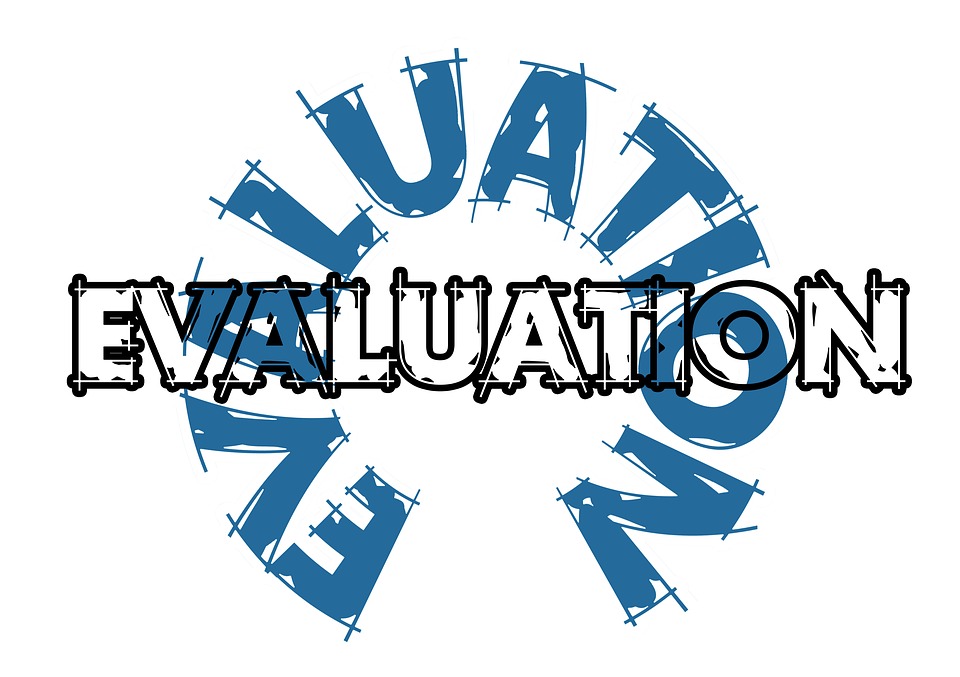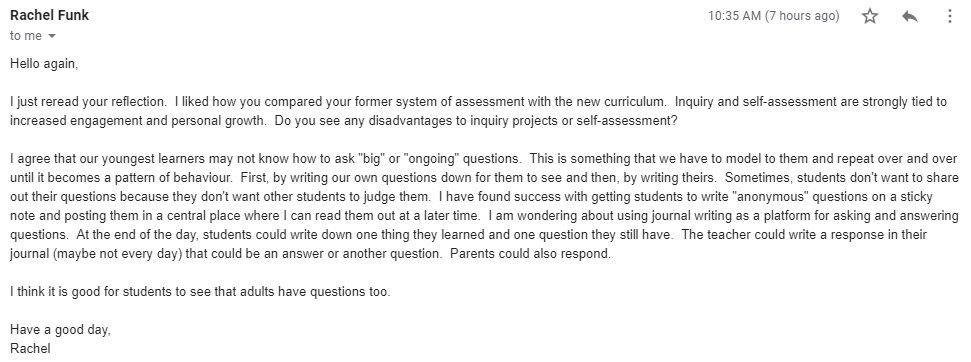Assessment
While assessment is not a new topic, it is constantly being discussed and revised. Based on the previous curriculum where teachers were expected to meet the Prescribed Learning Outcomes (PLO) goals, there was an emphasis on evaluating content. Teachers were bombarded with multiple PLOs for each topic and were expected to report on as many of them as possible. Therefore, not only were report cards excruciatingly long and time-consuming, for many educators, the main goal was focused on a teacher-centered classroom where students learned the material and regurgitated their learning. For many, the PLOs were used as assessment guides and were converted into rubrics. I was exposed to this method of learning and teaching and felt a strong sense of antipathy and reservation on its effectiveness as I am more of a creative learner and teacher. Reciting facts without truly absorbing the material and relating it real life was meaningless for me. This method was neither valid, nor reliable as my ideas and relationship to the learned material was different from other students as I provided an atypical perspective in relation to Canadian born students (Tierny, 2019).
Prior to applying to the Education Program at the University of British Columbia (UBC), I was fortunate enough to be accepted to volunteer at a school where students were predominately new immigrants and refugees. My mentor teachers opened my eyes to the differences in their learning styles and in the time that each student required to absorb the material. In this school, many students were trauma survivors, so the curriculum was not the most essential teaching element. Social skills, adaptation, and building trust were far more important to establish early on in order to provide a stronger basis for engagement in the expected curriculum. We created a safe space for students and engaged them in learning through fine arts and play. Sometimes they were given tests, such as for math or French, but for the most part, they did not realize we were assessing them as we did it subtly based on where we thought their learning should be in regards to their individual circumstances. This took a great deal of time and effort on the teacher’s part but the results were phenomenal. Students enjoyed studying and were not worried about their achievement. Children are naturally curious beings and want to learn as much as they can. During my time in the Education Program at UBC, we learned about the “new” curriculum where we were taught to focus on the big idea, core competencies and curricular competencies instead of the content. This switch felt more natural for me as the parameters of what could be taught within the classroom changed. While teachers must teach the content area, it is has been drastically shortened and left intentionally broad. This way, there are no specific restrictions on how to teach the content and where to adapt it for individual students. For instance, when reading a book about creating and maintaining friendships, teachers can now focus on “reading comprehension” by assessing students “background knowledge” to create meaning (Tierney 2019, p. 2). According to Robert Tierney (2019), the comprehension level of a student is “tied to their own interests, needs, goals, histories, motivations, and methods of engaging. Understanding are shaped by the purposes that reader set the perspectives that they adopt, their stances, their relationships to the author and other readers and other contextual influences” (Tierney 2019, p. 2). Instead of asking specific guided questions, we may now pose broader questions for students to reflect upon. They can then take this a step further by sharing their ideas with their group to gain new perspectives, which can lead to full class discussions. Pupils can then write about any new ideas. We can also teach learners to ask their own big questions, which can lead to an inquiry project. In this way, students are engaged in their learning through the process of reflective thinking. This enables teachers to assess them on their reading and writing comprehension in a more realistic format as students are showcase their learning in their own way. I use this method in my class and it works well as students are able to learn and be evaluated at their own pace.
During my time in the Education Program at UBC, we learned about the “new” curriculum where we were taught to focus on the big idea, core competencies and curricular competencies instead of the content. This switch felt more natural for me as the parameters of what could be taught within the classroom changed. While teachers must teach the content area, it is has been drastically shortened and left intentionally broad. This way, there are no specific restrictions on how to teach the content and where to adapt it for individual students. For instance, when reading a book about creating and maintaining friendships, teachers can now focus on “reading comprehension” by assessing students “background knowledge” to create meaning (Tierney 2019, p. 2). According to Robert Tierney (2019), the comprehension level of a student is “tied to their own interests, needs, goals, histories, motivations, and methods of engaging. Understanding are shaped by the purposes that reader set the perspectives that they adopt, their stances, their relationships to the author and other readers and other contextual influences” (Tierney 2019, p. 2). Instead of asking specific guided questions, we may now pose broader questions for students to reflect upon. They can then take this a step further by sharing their ideas with their group to gain new perspectives, which can lead to full class discussions. Pupils can then write about any new ideas. We can also teach learners to ask their own big questions, which can lead to an inquiry project. In this way, students are engaged in their learning through the process of reflective thinking. This enables teachers to assess them on their reading and writing comprehension in a more realistic format as students are showcase their learning in their own way. I use this method in my class and it works well as students are able to learn and be evaluated at their own pace.
Currently, there is also a move toward self-assessment. This is done in the form of reflections and is being incorporated into report cards. Students are able to voice their opinions about their educational development in regards to the core competences. I understand how to have students “reflect upon their progress,” “understandings, and uses of the text,” but I am uncertain about how to have them report on “ongoing questions” and “approaches” (Tierney, 2019, p. 2). I would like to learn more about how to teach students how to ask and answer big questions in regards to themselves and their educational progress. I am finding that students do not truly understand this concept and am wondering if there is any research available to teach students, especially young children about this concept as it is important to start this process during their primary years. Self-assessment does not come naturally to everyone and takes time to master.
Overall, though, I really enjoy self-assessment as when it is taught to and explained to students, it actually holds them accountable for their learning. In this way, they feel a sense of agency in their education as they understand that it is based on their growth instead of it being a competition between themselves and others. Is this method of assessment valid and reliable? What are other best practices for teaching self-assessment and for creating rubrics?
Responses


